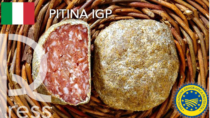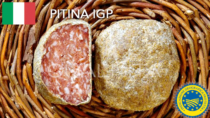Description
Pitina PGI is a charcuterie product obtained from a mixture of one part (minimum 70%) lean sheep, goat or wild ungulate meat, limited to species of roe deer, fallow deer, red deer, chamois, and one part bacon fat or pig shoulder.
Production Area
The production area of Pitina PGI is exclusively within the territories of the municipalities of Andreis, Barcis, Cavasso Nuovo, Cimolais, Claut, Erto Casso, Frisanco, Maniago, Meduno, Montereale Valcellina, Tramonti di Sopra and Tramonti di Sotto, in the Province of Pordenone, in the Friuli-Venezia Giulia region.
Production Method
In the first stage of processing, the bones, fat and tendons are removed from all the meat; the rind and any loose strands of fat are removed from the pork. The meat is then minced, using plates with holes with a diameter between 4.5 and 7 mm. The mince is then mixed with the seasoning, consisting of sea and rock salt, fresh herbs and aromatic herbs. The mixture is then divided into ball-shaped portions, each weighing between 150 and 400 g, which are then sprinkled evenly with corn flour. The next stage is smoking, which lasts between 4 and 48 hours, using beech, hornbeam or fruit tree wood or sawdust, which can be alternated with drying. The product is then cured in rooms with open windows and a temperature between 3 and 18 °C, with humidity varying between 60 and 90%.
Appearance and Flavour
Pitina PGI is hemispherical, with an external colour ranging from golden yellow and yellow-brown; when cut, the colour varies between bright red and intense burgundy, with darker edges. The meat is lean with a very fine grain. The final product weighs between 100 and 300 g. It is sapid with a characteristic smoky aroma.
History
Given the lack of written evidence, the history of Pitina is mostly recounted through oral testimonies. Researchers explain that this was due to the fact that although both its preparation and consumption were widespread in the early nineteenth century, the product was never used as a commodity. Furthermore, it was considered a "poor man’s" meat, linked to the working-class family environment and not eaten by the rich. The need to preserve the little meat available, mostly ovine or poached game, led to the development of preservation techniques like smoking and stabilization with the addition of pork fat. The name "Pitina" was originally used in the Tramontina Valley thanks to the first producers: the inhabitants of the municipality of Tramonti di Sopra. And also thanks to them, the local tradition was revived in 1969 , when they organised the first “Pitina Festival", which since then has been held annually every July.
Gastronomy
Pitina PGI is mainly served as raw slices, but it can also be cooked in various ways, for example, in polenta broth aromatised with juniper and rosemary, and grilled or lightly fried in vinegar and served with polenta. The traditional dish "Pitina al cao", where it is cooked in freshly milked cow's milk, is also delicious, as is browning it with butter and onion and adding it to potato soup. It pairs perfectly with all the great white Friulian wines.
Marketing
The product is marketed as Pitina PGI. It is sold whole, vacuum-packed or packaged under a modified atmosphere.
Distinctive Features
Created to preserve meat in the autumn, Pitina PGI owes of its characteristic of being a cured, but not dried meat to the distinctive production method and the unique climatic profile of the area, a pre-Alpine enclave characterised by heavy rains, but no stagnant humidity.










